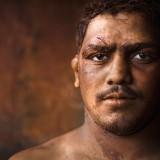When an Indian Kushti wrestler rolls in the earth, his hair and body become covered in the burnt-umber hue of soft clay. It’s said that he becomes “of one color.” This is meant literally of course — his black hair is matted down by the same mud that covers his body — but it also conveys a spiritual ideal. Wrestling in India, which counts Kushti as one of its indigenous disciplines, has a monastic history. Winning a wrestling match (or a Kushti-Spardha) isn’t the ultimate goal. The attainment of a kind of virtuous integrity of mind, spirit, and body is: being of one color.
Higher aspirations than victory shouldn’t be mistaken for softness. Kushti fighters are strong and they live to train and fight. Like Aussie Muay Thai fighter James Polodna, who literally lives at Montreal’s Tristar Gym and isn’t allowed company, Kushti fighters reside in their training facilities and submit themselves to a Spartan routine. They abstain from alcohol, drugs, meat, and women. They live apart from society because theirs is not a universal pursuit. Life in the akhara, the monastery-like gyms where upwards of 60 fighters live and train, is rigorous and austere. Yes, there’s glory in victory, but it’s fleeting. To Kushti wrestlers, there’s immortality in the cultivation of the essence of strength.
That strength starts with the mud. Students at akharas cart hundreds of pounds of soft earth from riverbanks and lakebeds to their gyms every few weeks. That earth is mixed with oil, turmeric, rosewater, and sometimes buttermilk to create a fragrant, pleasing surface on which training exercises and bouts take place. The wrestling pit is covered, either by a thatch or concrete roof, to keep out the sun. Training is an orchestrated chaos of arched limbs and strained faces. Holds, moves, countermoves, throws are practiced in the rich darkness.
Days are regimented. Early in the morning every fighter studies under the guru of the akhara and practices a series of moves and countermoves called Jor (literally “exerting force”). This complex vocabulary of grappling includes familiar freestyle wrestling takedowns and more exotic, and potentially dangerous, maneuvers like using your head to pivot your body out of a hold. These moves are practiced until they become rote.
After morning practice the wrestlers eat. Their diet is highly structured as well. They’re all vegetarians and so they get their protein from a thick mixture called Khurak, made from clarified butter (ghee), milk, almond paste, or chick peas. They eat great volumes of this stuff. There are tales of fighters who would go through 50 pounds of ghee and 80 pounds of almonds a week. The better part of the afternoon is spent resting and followed by another regimen of strengthening exercises. Then more Khurak. Then sleep. When fighters compete they do so at raucous village festivals called Kushthi-spardhas that thousands in India’s north and central regions attend. These competitions tend to last all day, with featured fights unregulated by time or scoring. Pinning a man is the only way to win.
In other words, there are thousand differences between Kushti and modern-day mixed martial arts (the diaper-like loincloths the fighters wear differ significantly from ad-covered MMA shorts, and American MMA gyms are rarely, if ever, dedicated to monkey gods). But the differences are actually only superficial. The ethos of restraint, the cloistering off from society, and the aspiration towards achieving something transcendent are shared by both kinds of fighter. So is the yearning for competition.
And just like MMA and other western combat sports, kushti has its own legend — its Babe Ruth, its Muhammad Ali, its Fedor Emelianenko. Joseph S. Alter, an anthropology professor at the University of Pittsburg and scholar in Indian fighting, told me about the Great Gama, a Kushti fighter from the outskirts of Amristar in the Punjab who rose through the ranks of Akhara training, became a national champion in India by the age of 19, and, at the invitation of British wrestling promoter, landed on the cold shores of England in 1910. Once there, he won the John Bull belt by defeating Stanislaus Zbyszko in bout that lasted three hours. The Great Gama became world champion.
So, when the UFC announced that it would launch The Ultimate Fighter: India in 2013, at a press conference in Mumbai on September 11, 2011, and Man Jit Singh, the CEO of the company the promotion would be partnering with, pointed to India’s “long legacy of Kushti,” and said he hoped that “our fighters from the akharas and gyms will progress and eventually become UFC champions,”the questions were obvious: Could kushti find its way into the MMA fighter’s technical vocabulary, and could India once again produce a world champion?
Prof. Alter was intrigued when I put the question to him, but he warned that there is what he called an “idiosyncratic rather than pervasive masculinity” in Indian culture that complicates the rise of Indian wrestling and could keep it from having the kind of influence on the development of MMA some might hope for.
“Masculinity is more nuanced in the sense that there are two related dimensions,” he said. “It’s linked to self-discipline and the moral, non-violent, balanced, and considered restraint. The preservation of the essence of masculinity is what’s valued. That’s what makes a strong person.”
By Krishna Andavolu
Vice
Photos by Mitchell Kanashkevich
(2001)













